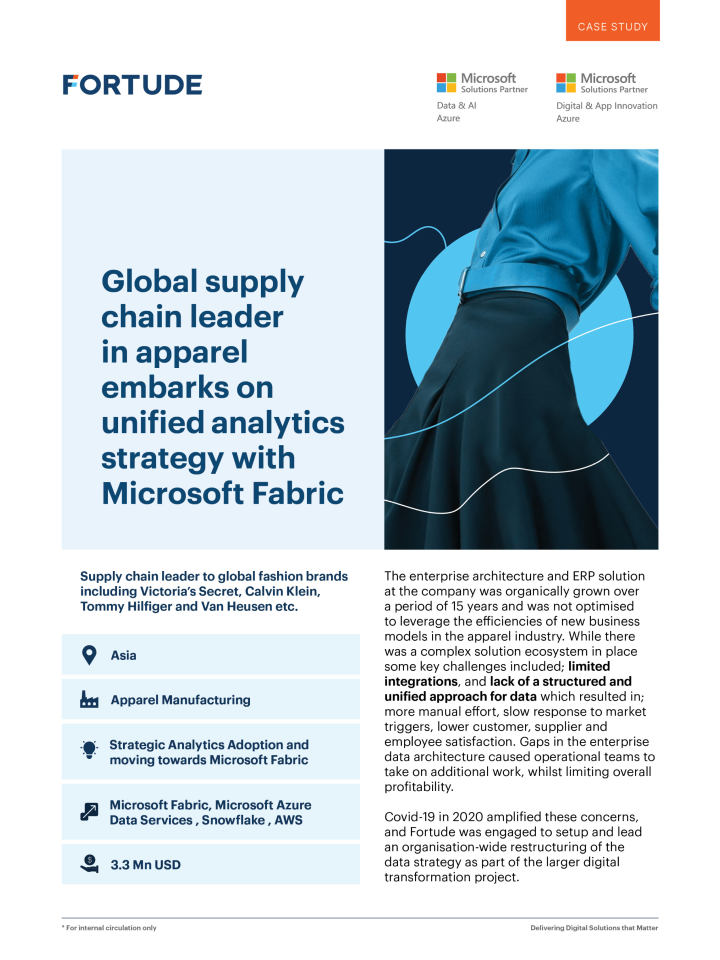Supply chain leader to global fashion brands including Victoria’s Secret, Calvin Klein, Tommy Hilfiger, and Van Heusen etc.
The enterprise architecture and ERP solution at the company was organically grown over a period of 15 years and was not optimised to leverage the efficiencies of new business models in the apparel industry. While there was a complex solution ecosystem in place some key challenges included; limited integrations, and lack of a structured and unified approach for data which resulted in; more manual effort, slow response to market triggers, lower customer, supplier and employee satisfaction. Gaps in the enterprise data architecture caused operational teams to take on additional work, whilst limiting overall profitability.
Covid-19 in 2020 amplified these concerns, and Fortude was engaged to setup and lead an organisation-wide restructuring of the data strategy as part of the larger digital transformation project.
Over 13 business units were interviewed and information needs were reviewed together with SMEs, vendors and industry experts. Subsequently a 2-year analytics adoption plan was drawn up, with investments exceeding USD 3Mn for the first 2 years. Implementation and governance processes were setup to make sure the analytics adoption program delivers 2x benefits in the short term, with efficiency improvements in access to information needs.
The roadmap was a starting point for multiple analytics initiatives across the organisation, including building a central analytics team, comprehensive data architecture, change management, training, and integrated processes across value chains.
The company will leverage its unified analytics capabilities to further position itself as a global leader in providing inspired apparel solutions for top fashion brands.
An analytics adoption strategy that unifies the business
The analytics adoption strategy at a glance.
- Centered around core enterprise solutions:
Infor M3 ERP, PLM and a Manufacturing Execution System (MES) with a multi-cloud (AWS/Microsoft) tech stack. - 2-year blueprint in collaboration with industry SMEs.
- Supported by a strong central analytics team, processes and governance.
- Empowered business users with self-service analytics and promoting citizen developer/data science culture.
- Sharp focus on end-to-end information process improvement and business benefit realisation.
Migration to Microsoft Fabric
To align with the modernisation strategy, Fortude executed a phased migration from a multi-platform data stack (Snowflake, AWS, etc.) to Microsoft Fabric. This transformation followed an in-depth evaluation and successful proof of concept, with a unified, scalable, and AI-ready data platform as a result.
Strategic benefits
- Simplified stack: Replaced multiple tools with a single SaaS platform combining data engineering, warehousing, and BI.
- Faster insights: Direct Lake mode enables high-speed reporting without data duplication or refresh delays.
- Cost efficiency: Retired legacy systems, reduced licensing and infrastructure spend by consolidating into one Microsoft capacity model.
- Stronger governance: Centralised access control, auditability, and compliance leveraging Azure AD and Microsoft Purview.
- AI and future-ready: Seamless integration with Microsoft 365, Power BI, Azure ML, and Copilot to accelerate AI adoption.
This shift not only simplifies operations but also positions Fortude to scale data and AI initiatives more effectively across the enterprise.
Key migration activities
- Data warehouse: Migrated from Snowflake to Fabric.
- Lake house: From AWS to OneLake.
- Semantic data models: Shifted to direct Lake mode for real-time insights.
- Security: Consolidated into a single governance and security model.
- AI readiness: Enabled built-in Copilot and ML capabilities.
Impact
The analytics adoption program was driven as a subset of the digital transformation program and had significant impact on the overall view of technical solution delivery, solution acceptance by business users and value realization.
- Opportunity to significantly increase operational efficiency due to enterprise data warehouse and analytical dashboards.
- Eliminated manual data crunching and duplication of work.
- Improved customer experience due to shorter response times and better visibility.
- Empowered employees to better focus on strategic outcomes.
- Enabled faster decision making.
- Increased the adoption of digital practices across the company.
- Built a training platform to onboard business users.
Unifying analytics across the organization
- Delivered the analytics roadmap and set up central analytics team to empower and maintain governance of all data products and assets.
- Comprehensive data and governance architecture.
- Analytics adoption blueprinting with SME vendors.
- Re-implementation of the core data platform from scratch.
- Detailed change management, evangelizing and empowerment plan towards self-service analytics.
- Unified DevOps and support alignment for sustainability.
- Consolidation of entire tech stack under Microsoft Fabric.
Download Case Study

Related Case Studies
Subscribe to our blog to know all the things we do



